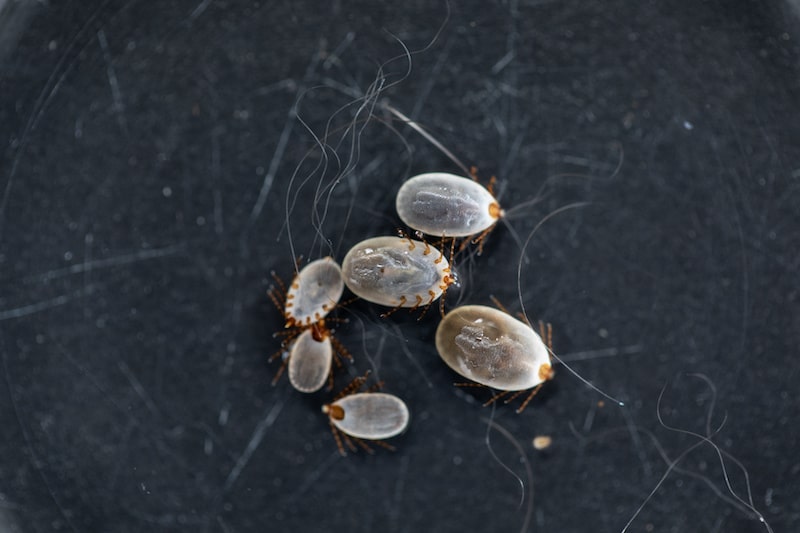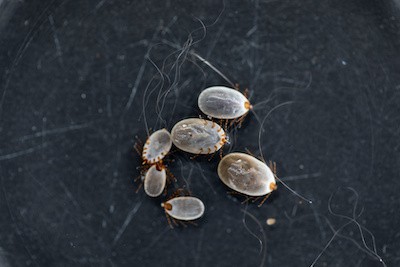
27 Nov Do Fleas Go Away in the Winter?
What to Know About Fleas in the Winter
Fleas are tiny creatures that can be big nuisances for you, your pets, and your household. These little critters usually enter homes by catching a ride in the fur of your pet; from there, they can quickly reproduce and multiply. Before you know it, your home is infested. You think you’ll find some relief when winter hits since most insects and bugs die off at this time anyway.
Do fleas go away in the winter? While cold temperatures can kill off outside flea populations, fleas, unfortunately, do not go away in the winter if they are in your home or on your pet. Fleas caught outside may be more likely to migrate inside or find a pet to inhabit. Flea activity may seem scarce during the winter as the fleas can do dormant in this time; however, flea eggs on your pets or in your house can hatch in the winter.
Once your house is infested with fleas, it can be difficult to get rid of them. Their tiny size makes it easy for them to hide and the flea’s ability to jump quickly from one place to another keeps them from getting crushed or caught. When it comes to ridding your home of these durable little creatures, it’s important to know more about them. Keep reading to learn how to get rid of fleas, even during the winter months!
Will Winter Temperatures Kill Fleas?
 Fleas thrive in warm and humid environments while cold temperatures can be enough to kill adult fleas, larvae, and eggs. The colder temperatures that come with winter can be enough to kill off outside flea populations. When the temperature hits 37 degrees Fahrenheit, fleas will start to freeze; however, there must be a prolonged time of these freezing temperatures before the fleas will die. Man, these buggers are hard to kill.
Fleas thrive in warm and humid environments while cold temperatures can be enough to kill adult fleas, larvae, and eggs. The colder temperatures that come with winter can be enough to kill off outside flea populations. When the temperature hits 37 degrees Fahrenheit, fleas will start to freeze; however, there must be a prolonged time of these freezing temperatures before the fleas will die. Man, these buggers are hard to kill.
There need to be continuous days where the temperatures do not get above 37 degrees Fahrenheit for the fleas to eventually die. If the low for the day is below this temperature but the high for the day is above, the fleas can de-thaw and go about their business. If you live in a southern area where winter temperatures stay mild, then you should not trust the weather to do the job of killing off fleas.
Can Fleas Survive in My Home During the Winter?
Fleas are notoriously hard to get rid of. When temperatures start to drop outside, fleas will be more apt to cling to the warmth of your pet and find their way indoors to where temperatures are higher. You could easily find yourself dealing with an infestation, even during the winter months. Once the fleas find their way indoors, they can hide in upholstery, cracks, clothing, and carpets. You may not even realize that the fleas are there until it’s too late.
Winter Flea Infestation Prevention Tips
Just because it’s winter doesn’t mean that you shouldn’t take some preventative measures to keep your home free of fleas. Just because you don’t see them doesn’t mean that they aren’t there. This is especially true if you have dealt with flea infestations in the past. Flea eggs can stay dormant for a while before hatching, causing an entirely new problem. Follow these steps to prevent fleas from thriving in your home during the winter:
Bathe Your Dog Regularly
Once it starts to get cold outside, many pet owners refrain from giving their pets a bath. During the winter, many dogs may go for long periods of time without being washed. This gives fleas the perfect opportunity to start multiplying and thriving.
You should continue to bathe your dog regularly during the winter months to ward off any unwelcome flea guests. You can bathe dogs with a flea shampoo every 1-2 weeks to help prevent fleas from reproducing and eggs from hatching.
By giving your dog a bath frequently, you will be able to check their coat for signs of fleas. If your dog has fleas, they may have red itchy bumps on their skin and black clumps of feces in their fur. Keep an eye out for these signs of flea infestation. Chances are that if your dog has fleas, your home probably has fleas too.
Vacuum and Clean Your Home Regularly
One of the best ways to prevent fleas from thriving in your home is to regularly vacuum and clean your home. Vacuum all carpets and rugs, as this is where fleas love to hide. Dust around window sills and cracks that would make ideal hiding places for critters.
Even if you don’t notice a flea presence in your home, there could be dormant eggs hidden in carpets and rugs. By vacuuming regularly, you can remove the eggs from your home before they hatch. This measure will prevent a flea population from forming or getting worse.
If you do happen to vacuum up living fleas, it’s important to know that fleas are the best escape artists. If you empty your vacuum into the trash can in your kitchen, the fleas can easily escape and go right back to where they were. For this reason, empty your vacuum into a sealable bag or empty the bag into a trashcan outside. This will keep the fleas from escaping and getting back into your house.
Look for Signs of Fleas
If there are visible signs of fleas in your home, then it’s time to take action and get your home treated for the pests. If you don’t know much about fleas, then you probably don’t know what visible signs you can look for. One of the most notable signs is little black specks on your window sills, in your bed, or on your furniture. These black specks are flea waste. It can also clump up in your pet’s fur. Check your pet’s sleeping area for signs of flea waste as well.
Another common sign that there may be fleas in your home is if your pets or even yourself are suffering from unexplainable itchy red bumps over your skin. Fleas feed on blood, so in order to survive, they have to bite other living things. These bites leave behind small itchy bumps.
If you find yourself waking up with these bumps over your body, chances are there may be fleas in your bed. Other times you may find yourself getting bit is when you sit in chairs or play with your dog. These are all areas that fleas will typically live.
Treat Your Home for Fleas
One way you can prevent fleas in the winter is by preventatively treating your home for fleas. This means that you treat your home even if there aren’t any visible signs that fleas are there. The reason for doing this is that fleas love to hide; they are very good at it. There could be flea eggs, larvae, and adults in areas of your house where you would never find them.
Flea treatments usually work into every nook and cranny of the house to kill any unwanted guest. You can use flea defoggers that set a fog throughout the house, filling every available space, or you can get the home professionally treated by a Broken Arrow Pest Control team. Either way, these preventative measures could save you from a flea infestation come Spring.
Once your home is infested with fleas, it can be hard to get rid of them. By taking preventative measures, even during the winter months, you can save yourself the stress of dealing with an infestation in the Spring. Do you have further questions about preventing fleas? Contact our team for all your pest control needs.

